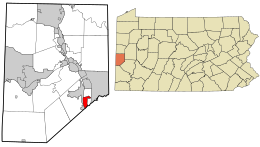Ambridge, Pennsylvania
| Ambridge, Pennsylvania | |
|---|---|
| Borough | |

The Rapp House in Old Economy Village
|
|
| Motto: Home to Old Economy Village | |
 Location in Beaver County and state of Pennsylvania |
|
| Coordinates: 40°35′35″N 80°13′31″W / 40.59306°N 80.22528°WCoordinates: 40°35′35″N 80°13′31″W / 40.59306°N 80.22528°W | |
| Country | United States |
| State | Pennsylvania |
| County | Beaver |
| Settled | 1824 |
| Incorporated | 1905 |
| Government | |
| • Type | Borough Council |
| • Mayor | Richie D'Ambrosio |
| Area | |
| • Total | 1.7 sq mi (4.4 km2) |
| • Land | 1.5 sq mi (3.8 km2) |
| • Water | 0.2 sq mi (0.6 km2) |
| Elevation | 764 ft (233 m) |
| Population (2010) | |
| • Total | 7,050 |
| • Density | 5,179.3/sq mi (1,999.7/km2) |
| Time zone | Eastern (EST) (UTC-5) |
| • Summer (DST) | EDT (UTC-4) |
| Zip code | 15003 |
| Area code(s) | 724 |
| Website | Borough of Ambridge |
Ambridge is a borough in Beaver County in Western Pennsylvania, incorporated in 1905 and named after the American Bridge Company. Ambridge is located 16 miles (25 km) northwest of Pittsburgh, alongside the Ohio River. The population was 7,050 at the 2010 census.
The town is near the location of Legionville, the training camp for General "Mad" Anthony Wayne's Legion of the United States. Wayne's was the first attempt to provide basic training for regular U.S. Army recruits and Legionville was the first facility established expressly for this purpose.
The Harmony Society first settled the area in the early 19th century, founding the village of "Ökonomie" or Economy in 1824. Although initially successful, accumulating significant landholdings, the sect went into decline. By the end of the 19th century, only a few Harmonists remained. The Society was dissolved and its vast real estate holdings sold, much of it to the American Bridge Company, who subsequently enlarged the town and incorporated it as Ambridge in 1905.
American Bridge attracted thousands of immigrants who came to fulfill their dreams of work, freedom, and peace. The steel mills became the focal point of the town. Most of the employees were relatives of relatives and the small town grew, with wards separating the town into ethnic sections. In addition, many of the ethnicities had their own church, club, and musical group that sought to give immigrants a familiar place to be as well as to preserve their culture. Many were from Eastern and Southern Europe including Italian, Greek, Slovak, Croatian, Ukrainian, Polish, Slovene, and Carpartho-Rusyn to name a few.
With the growth of the steel mills, Ambridge became a worldwide leader in steel production. The borough became known for bridge building, metal molding, and the manufacture of tubes (large iron pipes). During World War II, the American Bridge Company fabricated steel for the building of LSTs (Landing Ship Tanks). The steel was then sent by rail to the adjacent American Bridge naval shipyard in Leetsdale, PA where the LSTs were built. The area was also home to several other steel mills like Armco, the pipe mill which manufactured oil piping, and A.M. Byers, a major iron and tool fabricator. Eventually competition by foreign steel producers began to cause the share of the steel market for U.S. manufacturers to dwindle. With the shift of steel production overseas, the American Bridge Company ended operations in Ambridge in 1983. The legacy of American Bridge can be seen today in bridges around the world.
...
Wikipedia
